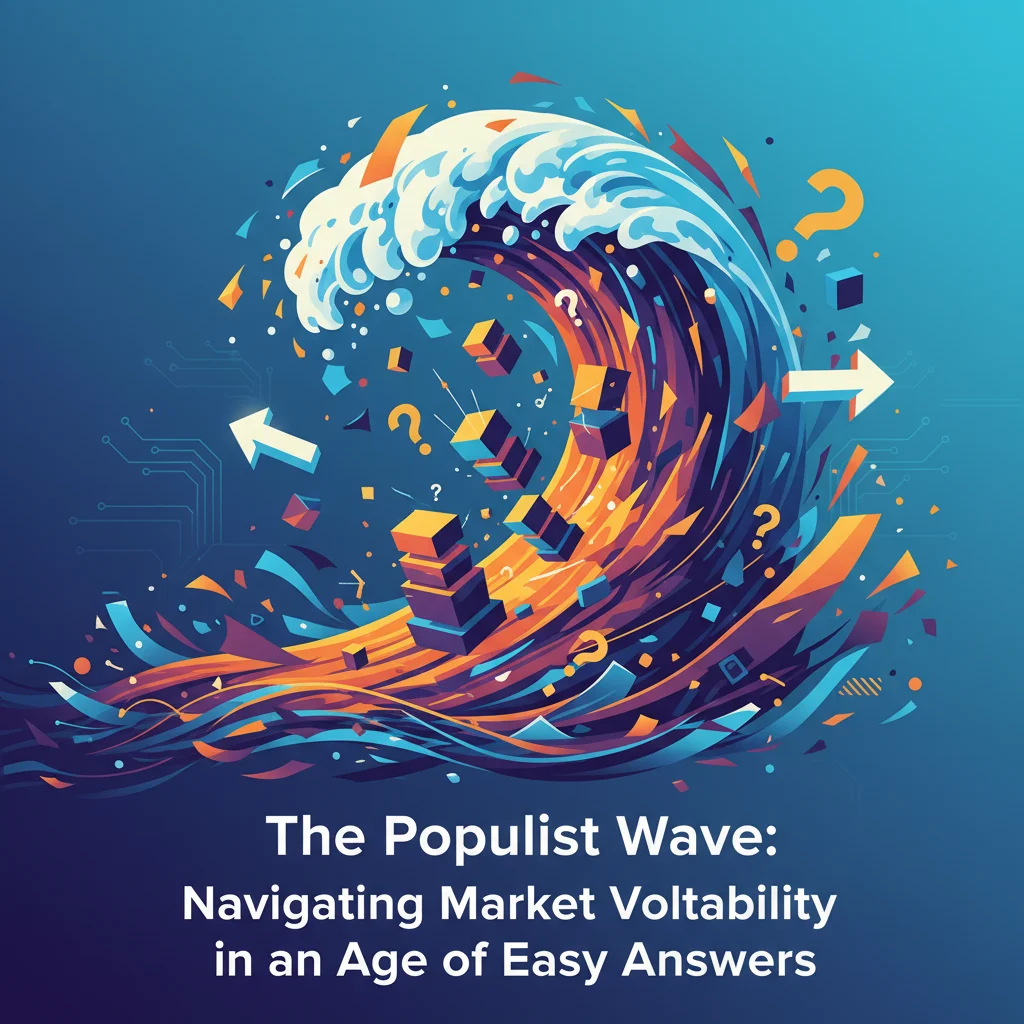
The Populist Wave: Navigating Market Volatility in an Age of Easy Answers
The Unsettling Rise of Economic Populism
In a political development that sent ripples through European markets, Ireland recently witnessed the election of Catherine Connolly, a president-elect who rode a powerful anti-establishment tide to victory. Her campaign, much like others gaining traction globally, was built on a foundation of seemingly simple solutions to complex economic problems. This event is more than a headline; it’s a crucial data point for investors, finance professionals, and business leaders. It signals a growing, cross-ideological movement—populism—that is reshaping the landscape of the global economy and challenging the very tenets of modern finance.
Populism, whether from the political left or right, thrives on a narrative that pits “the people” against a corrupt “elite.” This elite is often vaguely defined but almost always includes established financial institutions, multinational corporations, and mainstream economists. The proposed solutions are characteristically direct and emotionally appealing: tear up trade deals, nationalize key industries, cap prices, or dismantle the regulatory frameworks that govern banking and capital flows. While these promises resonate with a disaffected electorate, they introduce a level of uncertainty and risk that can have profound consequences for the stock market, investment portfolios, and long-term economic stability.
The Common Enemy: A Shared Distrust of the Financial System
At first glance, the economic platforms of left-wing and right-wing populists appear to be worlds apart. One advocates for radical wealth redistribution and state control, while the other champions nationalistic protectionism and deregulation. Yet, as the Financial Times article highlights, they are increasingly united by what they oppose: globalization, institutional expertise, and the intricate workings of the international financial system. This shared disdain creates a volatile and unpredictable policy environment.
For decades, the global economics consensus was built on principles of free trade, independent central banking, and predictable regulation. This framework, while imperfect, provided a relatively stable backdrop for international investing and business operations. The new populist playbook discards this entirely. For instance, a core promise of Connolly’s campaign was a “financial transaction review” aimed at penalizing high-frequency trading, a move that unnerved the country’s burgeoning fintech sector (source). This type of interventionist policy, driven by ideology rather than economic analysis, is becoming a hallmark of the new political era.
To clarify the divergent paths these movements can take once in power, it’s helpful to compare their core economic tenets.
| Policy Area | Left-Wing Populist Stance | Right-Wing Populist Stance |
|---|---|---|
| Trade & Globalization | Opposes free trade agreements as exploitative to workers; advocates for national self-sufficiency and fair trade. | Opposes free trade agreements as detrimental to national interests; advocates for tariffs and protectionism. |
| Taxation | Proposes significant tax increases on corporations and high-net-worth individuals; may introduce wealth taxes. | Often proposes tax cuts, particularly for domestic corporations, to boost national competitiveness, funded by tariffs or spending cuts. |
| Regulation | Favors heavy regulation of key sectors, especially banking and energy; may pursue nationalization of industries. | Favors deregulation for domestic businesses to spur growth, while increasing regulation on foreign entities and immigration. |
| Central Banking | Views independent central banks as serving the financial elite; may seek to influence monetary policy to fund social spending. | Views independent central banks with suspicion; may pressure them to prioritize national growth over inflation control. |
| Financial Technology | Suspicious of fintech and crypto as tools for speculation; may seek to heavily regulate or tax them. | Can be cautiously supportive if seen as a way to challenge the established banking “elite” and promote national champions. |
Beyond the Iceberg: What the Titanic Teaches Us About Modern Investing and Fintech
The Market Impact: From Volatility to Systemic Risk
For those involved in finance and investing, understanding the populist agenda is no longer an academic exercise—it’s a critical component of risk management. The “politics of easy answers” invariably leads to complex and often negative market reactions.
1. Heightened Stock Market Volatility
Uncertainty is the enemy of stable markets. Populist leaders often rely on unpredictable announcements and policy-by-tweet, creating sharp swings in investor sentiment. The threat of tariffs can decimate the stock value of import-dependent retailers, while talk of nationalization can erase billions from the market capitalization of utility and infrastructure companies. Reports indicated that Irish bond yields saw a 15-basis-point jump in the week following Connolly’s primary victory, a direct reaction to her party’s fiscal proposals (source). This demonstrates how quickly political risk is priced into financial assets.
2. Currency Devaluation and Inflation
Populist economic policies often involve massive increases in public spending funded by debt, or direct pressure on central banks to print money. This combination is a classic recipe for inflation and currency devaluation. As a nation’s currency weakens, the cost of imports rises, eroding purchasing power and corporate profits. For international investors, this means the value of their holdings can diminish rapidly, even if the local stock market is rising in nominal terms. A sound understanding of economics is vital to anticipate and hedge against these currency risks.
3. The Challenge to the Banking and Fintech Sectors
The traditional banking sector is a primary target for populist anger. This can manifest as calls for windfall taxes, forced lending to specific sectors, or even breaking up large institutions. This hostile environment stifles innovation and lending. Simultaneously, the financial technology sector faces a contradictory future. While it can be targeted for its disruptive and speculative nature, it can also be seen as an alternative to the distrusted banking establishment. The rise of decentralized finance (DeFi) and blockchain-based assets is, in part, a technological manifestation of the same anti-establishment sentiment that fuels populism.
Strategic Imperatives for a New Economic Reality
Navigating this landscape requires a shift in mindset. Political risk is no longer a secondary consideration; it is a primary driver of market performance. Both investors and business leaders must adapt their strategies accordingly.
For Investors:
- Geographic and Asset Diversification: Now more than ever, concentrating capital in a single country or asset class is a high-risk strategy. A well-diversified portfolio can cushion the blow from a sudden, politically motivated market downturn in one region.
- Focus on Fundamentals: In times of uncertainty, companies with strong balance sheets, low debt, and resilient cash flows are better equipped to weather storms. Scrutinize a company’s exposure to regulatory changes and international supply chains before investing.
- Active Political Risk Analysis: Successful trading and investment strategies must now incorporate sophisticated analysis of political trends, election outcomes, and potential policy shifts.
The Steak: Deconstructing High Beef Prices and the Flaws in Political Quick Fixes
For Business Leaders:
- Build Resilient Supply Chains: The era of relying on a single, lowest-cost supplier is over. Businesses must build redundancy and flexibility into their supply chains to mitigate the risk of sudden tariffs or trade disruptions.
- Engage in Scenario Planning: Leaders should actively model the potential impact of different political outcomes on their operations, from tax law changes to new regulatory burdens.
- Leverage Financial Technology: Businesses can use fintech solutions to manage risk. This includes using platforms for more efficient cross-border payments to circumvent traditional banking friction or employing blockchain for greater supply chain transparency and security.
From Red Ink to AI: Decoding the Tony Blair Institute's High-Stakes Strategic Overhaul
Conclusion: Beyond Easy Answers
The rise of figures like Catherine Connolly is a symptom of a deeper global trend. The “politics of easy answers” is a direct response to years of rising inequality and a feeling that the existing economic system is failing the average person. While the anger is understandable, the proposed solutions threaten to dismantle the very structures that support global economic stability. For the financial community, the challenge is twofold: first, to protect assets and businesses from the immediate volatility this new political reality creates; and second, to engage in the broader conversation about how to build a more inclusive and resilient economic model. Ignoring the message behind the populist wave is a luxury we can no longer afford. The future of the global economy depends on finding credible, sustainable solutions, not succumbing to the allure of a quick fix.


